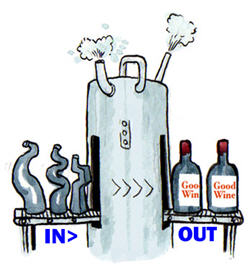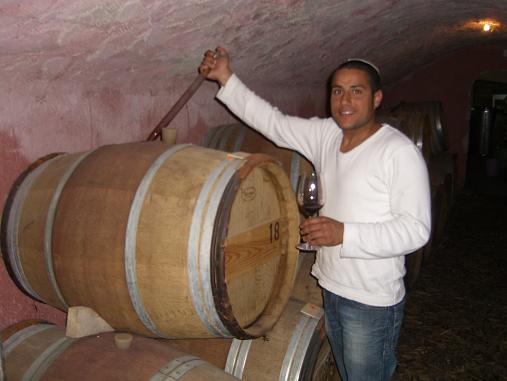Welcome to my 2nd annual Passover wine recommendations post. I hope you will forgive me as I begin with some shameless self promotion. My 2008 Passover wine recommendations can be found here. While I recently wrote an article for the Jewish Press about “blends” for Passover here.

Before I make my recommendations I want to reiterate something I constantly preach. DRINK WHAT YOU LIKE. Too many people focus on what critics, salespeople, friends or contemporaries tell them they SHOULD like. Nobody knows your palate but you. So try as much wine as you can and pick out wine that YOU will like for the Passover seder and your 4 cups.
OK, onto the wines that either I WILL be drinking or that I’d like to be drinking.
When in the US, I generally get deals on wine and rarely pay full price. A perk of working in the biz. But when I am in Israel, besides the occasional free bottle from winery friends, I generally pay full price. Considering that a 10 person seder X 4 cups per person equates to anywhere from 8-12 bottles, many of us will be watching our wallets and buying modestly priced wines.
Some of my favorite Israeli budget wines include the Golan Cabernet , Carmel Private Collection Cabernet, Dalton Canaan Red or just about any wine from Galil Mountain. The 2007 Galil Mountain Merlot is great, but I might look to spend a bit more and get the Galil Pinot Noir or newly released Galil Barbera. The first 4 wines can be found for the equivalent of about $10-12 in Israel and $12-15 here. While the mid priced Galil wines (Pinot & Barbera) should be under $20 in both countries. Others to consider in this price range are The Yogev wines and the Segal “Fusion” (blends I need to better familiarize myself with).
The focus of my recommendations will be non-mevushal Israeli wines. But if I were to pick a mevushal wine in the under $15 category I’d probably go with the Herzog old vine Zinfandel. I’ve been known to go for this wine in a restaurant that only serves mevushal wines as it’s both reasonably priced and of good quality.
Something I have not heard people consider when discussing the options for their 4 cups is sparkling wine. I know people like to drink red and sparkling is made for sipping (not chugging a full “cos”), but there are some nice sparkling options that should be considered. A favorite of mine, if you can find it, is the Yarden Blanc du Blanc. I have also tried the Adar de Elvi Cava Brut and enjoyed it. I have heard nice things about the Bellenda Prosecco as well as the Teal lake Sparkling Muscat. All of these sparkling options are under $20 and worth a shot. Did you know that sparkling wine is said to be “food neutral” and pairs well with ALL cuisine?
Before I dive into the Israeli selections there are a couple of non-Israeli wineries out there I’d like to briefly mention.
In New York I have been hearing really great things about Red Fern Cellars. I have not tried these wines yet, but I have been told that they are excellent. Just make sure you are getting wines from the 2005 vintage as earlier vintages were not as successful for this Long Island based winery.
From California, if you can find it, Four Gates is making great wines. Also worth considering are the wines of Hagafen or of course some of the Herzog reserve wines. While Four Gates is not mevushal, all the Hagefen wines are and most of the Herzog reserve wines are (now) mevushal as well.
From New Zealand I really like what Goose Bay has done with their Sauvignon Blanc as well as their Pinot Gris. While I enjoy all the Goose Bay wines these two in particular have a mouth watering acidity and freshness that are quite delicious.
I find most Kosher French wines to be either too expensive or simply not that good. But I admit that I am not as familiar with these as I’d like to be. Similar story with Kosher Italian wines though I have heard positive things about some of the Borgo Reale wines.
From Spain there are some high end wines that I really like. the Capcanes “Montsant” (AKA “Peraj Ha’Abib”) is a great wine as is the Elvi “El 26”. Problem is these wines are quite pricey ($50-60). The lower level wines from these wineries are nice, but I still think better options abound at these price levels from Israel.
Which is a good segue back into Israeli wines.
The Yarden Cabernet Sauvignon (2004) was actually the first ever Israeli (or kosher) wine named to Wine Spectator’s prestigious Top 100 wines (of 2008) list. I also like the 2003 Yarden Syrah. The 2002 is past its peak so if you are buying this wine make sure it is the ’03 or ’04. It has a classic peppery-ness with some old world gamey/smoked meat qualities.
Speaking of Syrah, and getting back to Galil Mountain, is the Galil Yiron Syrah. The brother to the classic “Yiron” (a bordeaux blend that is a long time favorite of mine) is different in style from the Yarden Syrah. This one screams California or even Washington State Syrah. BIG blueberries and plums, with a hint of pepper. A lovely new world style Syrah.
Staying in Israel, some wines I have raved about before are two “Appellation” wines from Carmel. The Carmel Appellation Carignan & Carmel Appellation Petit Syrah are unique varietals done very nicely by Carmel. They each come from old vines (which leads to deeper & richer wines) and are worth checking out if you want to try something different.
Speaking of unusual, when many of us think of red wine we quickly think of Cabernet Sauvignon or Merlot. But these wines are almost always very BIG and can over-power delicate foods. Some nice options for red wines that are not quite as big bodied are the aforementioned Galil Mountain Pinot & Barbera as well as my next recommendation; the Recanati Reserve Cabernet Franc. Cab Franc is one of the 5 Bordeaux varietals and this wine from Recanati is both light bodied and complex, showing interesting herbaceousness as well as chocolate notes.
Another winery that makes a Cab Franc is Ella Valley. I’d like to better familiarize myself with their wines which are a little bit higher in price ($20+ for the low end “Ever Red” and $30-$50 for their higher end and “vineyard choice” series), but I hear very good things. With vineyards throughout the Judean Hills this winery seems to be doing a great job with the fruit from this premium grape growing region.
Heading back up north to the Galilee I’d like to mention Dalton again. I grew up on the Dalton Canaan Red, moved onto the Dalton Estate Shiraz (a very rich & extracted wine) and have progressed to appreciating the Dalton reserve series. This progression is very common for wine drinkers. We begin enjoying easy to drink reds. Move up to big, fruit forward reds. And graduate to subtle, complex and elegant wines. While the subtle wines of Dalton don’t always garner the highest scores from critics (for reasons I don’t understand) these wines are sure to please the wine aficionado at your seder.
Two of the largest wineries in Israel, are Barkan and Binyamina. For many years these wineries were producing mediocre wines that were sold throughout supermarkets in Israel. But in recent years these wineries have really stepped up to the competition and have improved the quality of their offerings. I hear the Cabernet reserve from both Binyamina and Barkan, each priced around $20, are well worth the money.
Before I get to dessert, I’d be remiss not to mention the darling of Israeli kosher wines, Castel. This family run winery produces wines that are very old world in style – less fruit forward, more balanced, with subtle fruit, herbs & earth characteristics. The wines are not cheap, but if you want to splurge on something special you can’t go wrong with the Castel Grand Vin.
If you are still reading, CONGRATULATIONS, you are a real wine-O! Or at least an aspiring aficionado.
I’d like to finish off by mentioning some terrific dessert wine options. And they come from Israel’s most well known wineries, Yarden & Carmel. Beginning with the Yarden Muscat, this wine, which comes in a 500ml. (and very aesthetically pleasing) bottle is a fun treat. It costs about $15 and is fortified with Brandy. It is a nice digestif and goes great with anything sweet. Carmel makes their “Shaal” Late Harvest Gewurtztraminer, which is also a very nice option. Or you can splurge a bit ($30 for 375 ml.) and go with the highly rated Yarden “Heightswine” (a play on “ice wine”). Made from Gewurtz grapes frozen in a commercial freezer, this rich & syrapy wine IS dessert.
Happy Passover kosher wine tasting!
WTG








